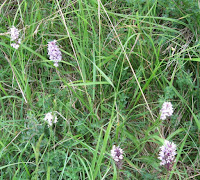The Uffington White Horse Hill (now in Oxfordshire) is one of these, and a favourite family place.
A few weeks ago we spent a lovely few hours climbing White Horse Hill, walking around Uffington Castle behind it and looking over the beautiful Vale of the White Horse with the Manger and Dragon's Mount beneath us.
Legend has it that King Alfred had the stylised horse carved through the turf into the chalk hillside to celebrate his victory over the Danes. He was born in Wantage (originally Alfredston) - a few miles up the road....actually, up the Ridgeway, the ancient trackway to the north of the hill...... But it wasn't him - probably much earlier, a bronze age tribe for whom the horse was sacred.
 |
| Just a glimpse of the horse as we walk towards it. |
 |
| Looking down to The Manger |
 |
| Looking down to Dragon's Mount |
Historians suggest that 'manger' is actually derived from a Saxon word meaning trader and that more likely a trading market was held here - not quite as romantic!
Dragon's Mount is properly magical!! It's a small hill at the foot of the main hill, the top of which is scarred and no longer grows grass at its centre. Back in the day it was a steep climb - now there are steps I see....
SO - St George slew the dragon there and where its blood spilled, no vegetation will grow. Fact - ancient peoples chopped the top off the hill to flatten it and used it for centuries for fires and beacons and consequently there is so much potash in the chalk sub-soil vegetation doesn't flourish. Shame.......I like the dragon story.
Just above the White Horse on the hill is Uffington Casle an ancient hill fort, steep sided and dry-moated. Our children flew kites and picnicked here - new thinking has moved from a theory of defence to simple security for people, animals, community and trading. To my delight, the familiar flowers that thrive on chalk were in much inevidence:orchids, wild thyme, bell flowers, rock roses and more. Magic.
 |
| Wild Orchids |
 |
| Rock Roses |
 |
| Thyme |
A lovely old solid metal sign - must be forty years old - tells us that The Ministry of Works is in charge of safeguarding this precious site. These days it will be English Heritage, but I'm glad they've kept the old signage and that sheep may safely graze.
Click on the pics for bigger versions.
Thank you for looking
Robin













